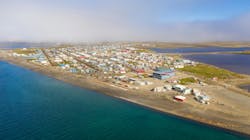Department of Energy Funds Microgrid Controller Projects
The U.S. Department of Energy (DOE) recently awarded $10.5 million to eight microgrid projects in underserved and indigenous communities.
The funding comes from the DOE’s Office of Electricity as part of its effort to support multiyear research, development and demonstration-replicable microgrid solutions. Specifically, these projects are designed to ensure low-cost, clean energy is available to underserved and indigenous communities in rural, remote and island regions.
Microgrid control technologies receive significant funding
The projects selected to receive funding are largely focused on the development, testing and deployment of different types of microgrid control technologies. Winners include:
- The Guam Power Authority in Mangilao, Guam, received $916,885 to develop, test and demonstrate a microgrid control system designed to standardize modular microgrid controls and communication.
- Intelligent Energy Systems in Anchorage, Alaska, was awarded $1.4 million to validate and standardize modular microgrid control systems designed for remote Alaskan communities.
- The Standing Rock Renewable Energy Power Authority in Fort Yates, North Dakota, was awarded $1.4 million to develop, prototype and demonstrate a modular microgrid system. The Design rEmote microgriDs wIth enhanced resilienCe: Analysis, protoTyping, and modularizATION, (or DEDICATION project), will feature advanced black start control.
Additionally, Purdue University in Indiana was awarded $1.4 million for the development and implementation of its Dynamic and Modular Microgrid control solution, and New Mexico’s National Technology and Engineering Solutions of Sandia received $1.23 million for its microgrid controller that leverages socioeconomic factors and situational awareness to optimize the controls of microgrids with multiple distributed energy resources.
The Alliance for Sustainable Energy was awarded a combined $4 million for three separate projects. The Colorado-based company aims to use artificial intelligence to reduce the cost and integration of microgrid controllers in remote communities, develop a universal modular, multiterminal, multiport medium voltage direct current microgrid controller, and create a workforce development framework in underserved and indigenous communities.
“We look forward to partnering with our selectees to bring reliable and resilient electric power to those who live and work in remote areas,” said Gene Rodrigues, assistant secretary for electricity at the Office of Electricity. “Developing and deploying microgrid-enabling technologies and addressing nontechnical barriers are essential elements of our commitment to meeting Americans where they are and working with the local resources available to their communities.”
The DOE has been investing heavily in remote microgrid technologies in recent months. Earlier this year, the agency announced it was accepting proposals for transmission projects that would connect remote and isolated microgrids to each other or to existing transmission corridors in Alaska, Hawaii and U.S. territories.
About the Author
Kathy Hitchens
Special Projects Editor
I work as a writer and special projects editor for Microgrid Knowledge. I have over 30 years of writing experience, working with a variety of companies in the renewable energy, electric vehicle and utility sector, as well as those in the entertainment, education, and financial industries. I have a BFA in Media Arts from the University of Arizona and a MBA from the University of Denver.

